Bibim Naengmyeon (Spicy Cold Buckwheat Noodles)
Bibim Naengmyeon is a spicy Korean cold noodle dish made with buckwheat noodles, zesty gochugaru sauce, and crisp toppings. Refreshing and bold, this summer favorite is easy to make at home with authentic flavor.
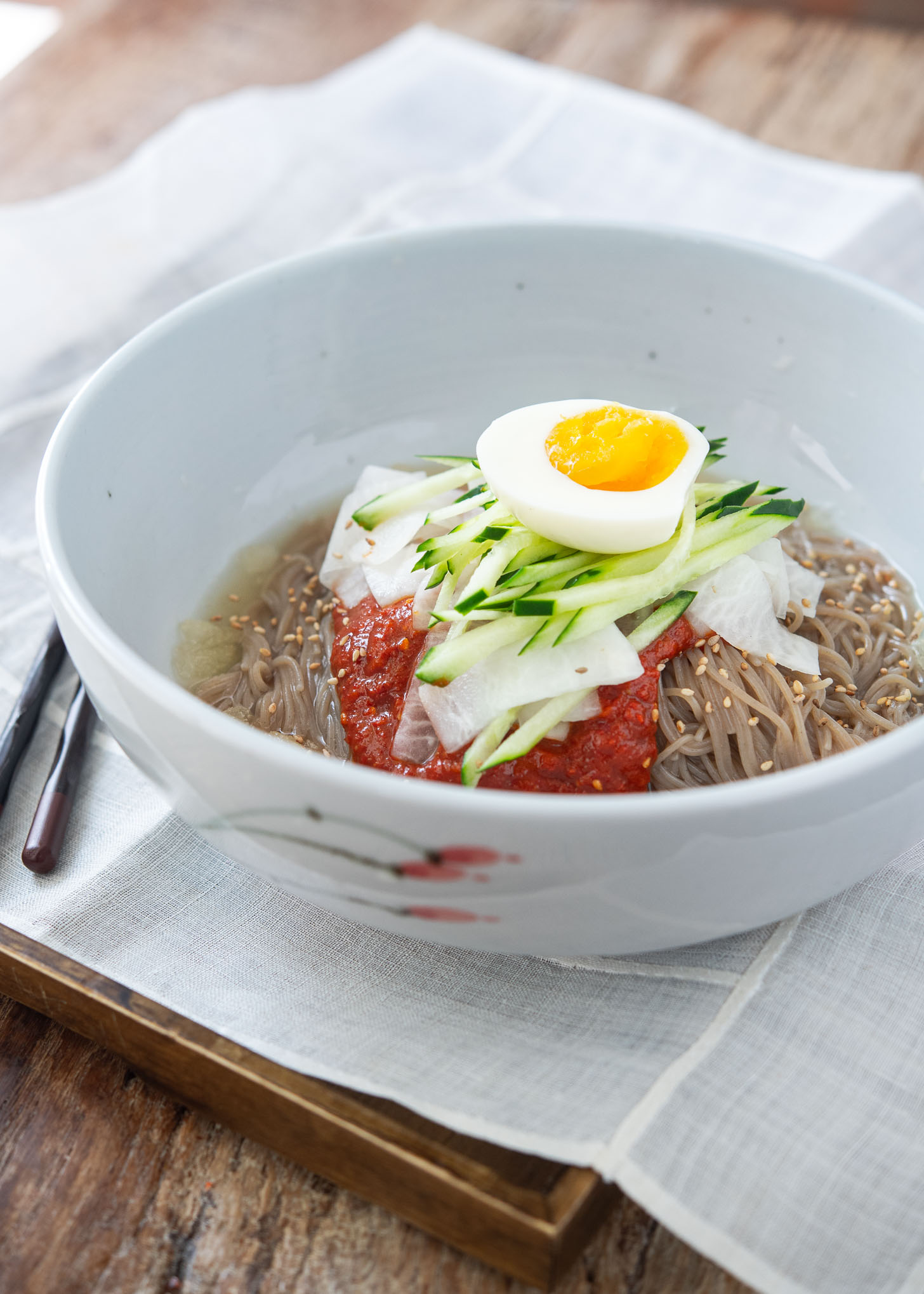
I didn’t grow up eating much bibim naengmyeon (spicy cold buckwheat noodles), and honestly, I regret it every time I slurp down a bowl of these spicy, chewy noodles. Naengmyeon hails from Korea’s northern regions—now part of North Korea—so it wasn’t a staple in my southern hometown. We had our own version of buckwheat noodles, but it was prepared very differently.
As my tastes evolved, so did my appreciation for naengmyeon—especially the bibim version, where cold buckwheat noodles are tossed in a punchy red spicy sauce and topped with crisp, refreshing veggies. There’s also mul naengmyeon, served in icy broth (and yes, I like both), but when I have to choose, bibim naengmyeon usually wins.
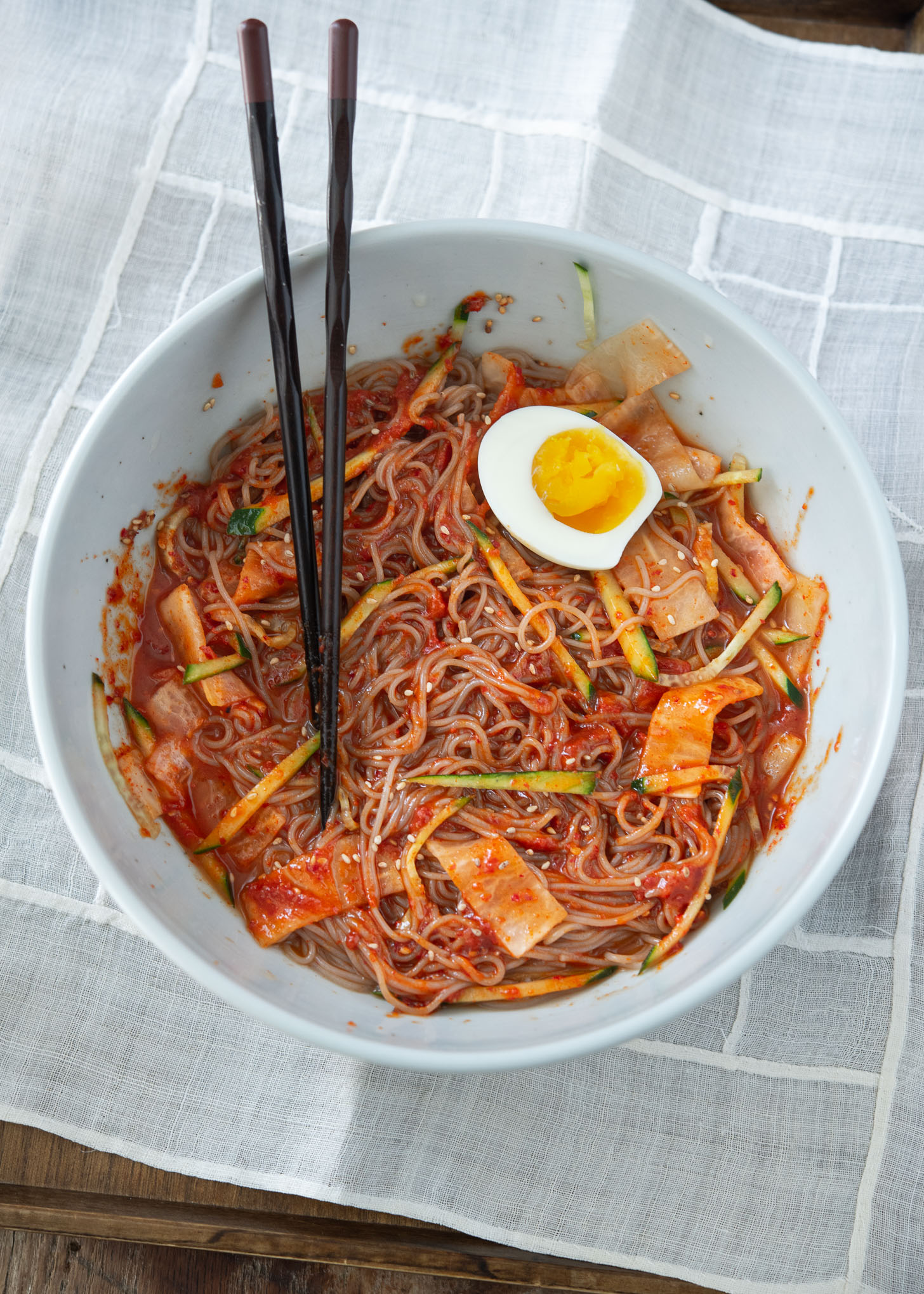
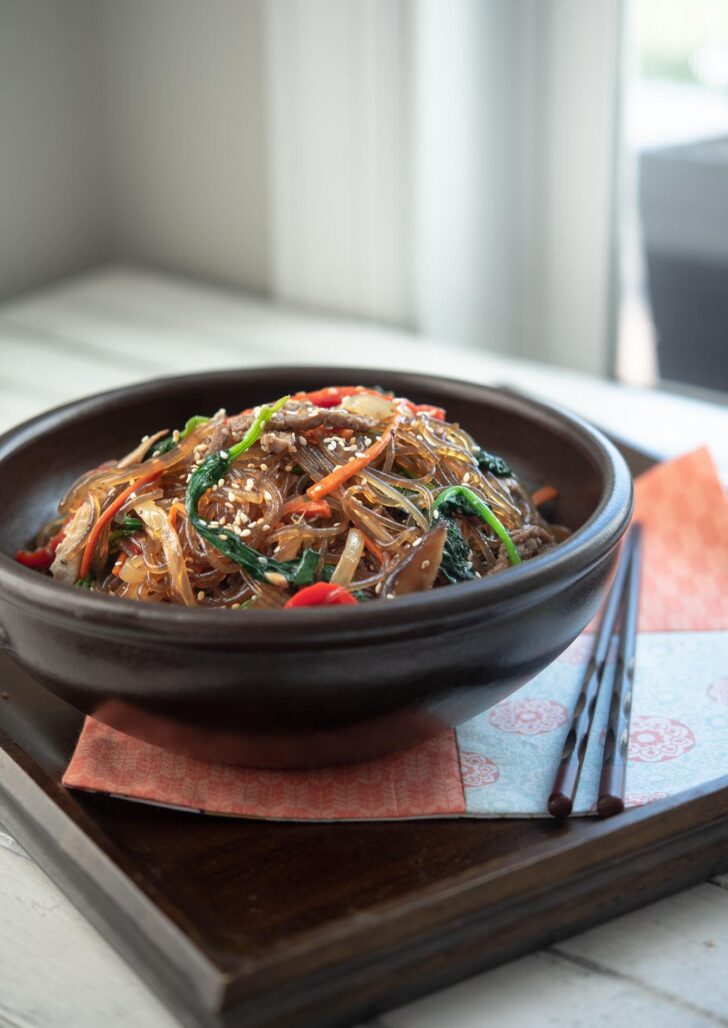
Get new recipes via email:
Over the years, I’ve sought out some of the best bibim naengmyeon spots in Korea and tested countless versions at home to recreate that unforgettable flavor. This recipe is the one I keep coming back to—bright, spicy, and slightly fruity for balance. And I’ll even show you a shortcut to nail the flavor without too much fuss.
If you’re new to Korean cold noodles, or just looking for something bold and refreshing for summer, this dish delivers. As long as you can handle a little heat, you’re in for a treat.
Prefer something milder with a kimchi kick? Try my Bibim Guksu (Cold Korean Noodles with Kimchi)—it’s made with wheat noodles and has a slightly tangier, lighter profile that’s just as slurp-worthy.
Key Ingredients for Bibim Naengmyeon
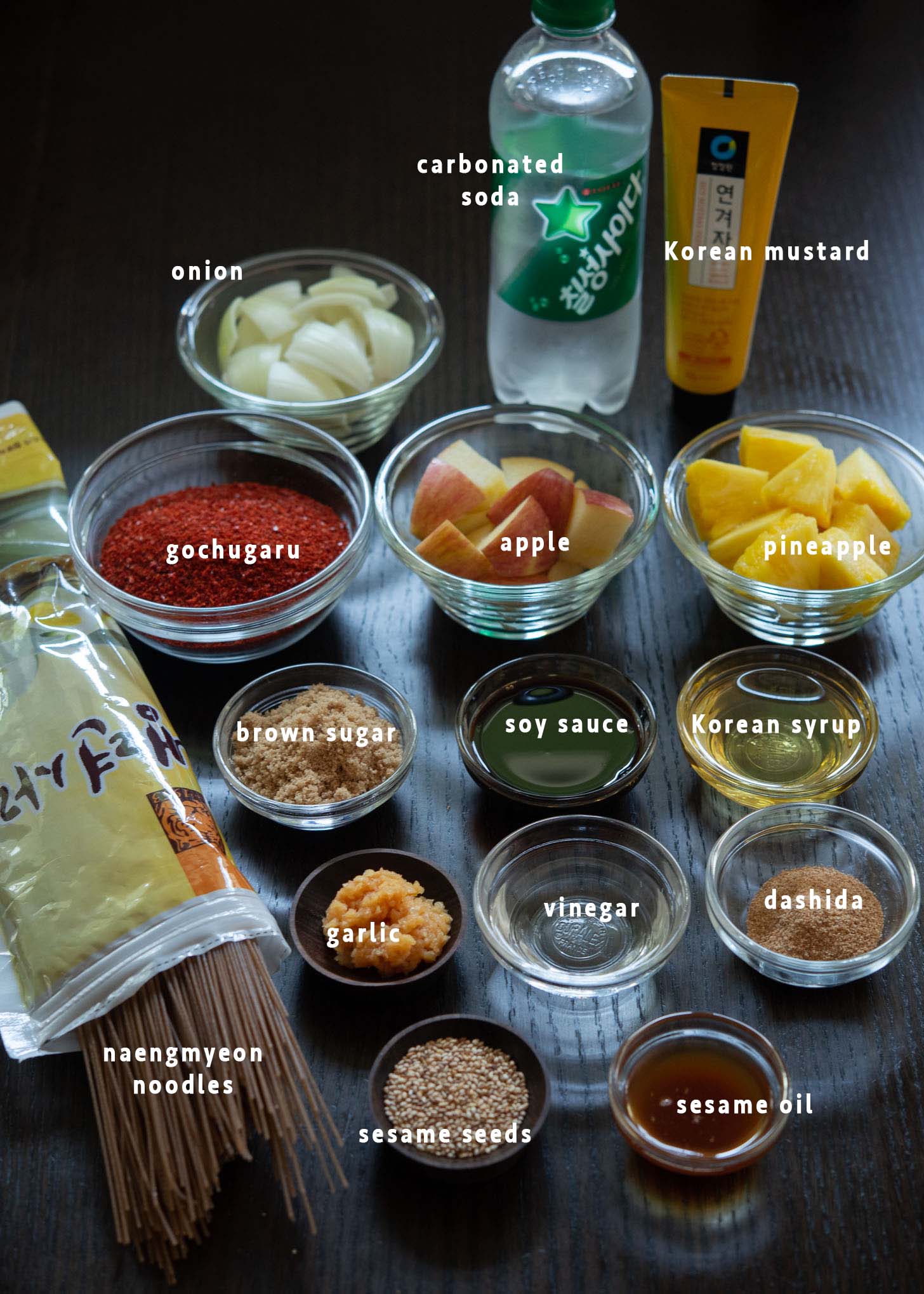
Naengmyeon Noodles (Buckwheat-Based)
For authentic bibim naengmyeon, use dried naengmyeon noodles (called anengmyeon sari, 냉면사리) made with a mix of buckwheat and wheat flour. They’re chewy, slightly nutty, and the texture holds up beautifully under spicy sauce.
Some brands come pre-cut (great for tangle-free serving), but if you get the long, traditional bundles, just snip them with kitchen scissors right before serving. That’s what most Korean restaurants do too—no shame in it!
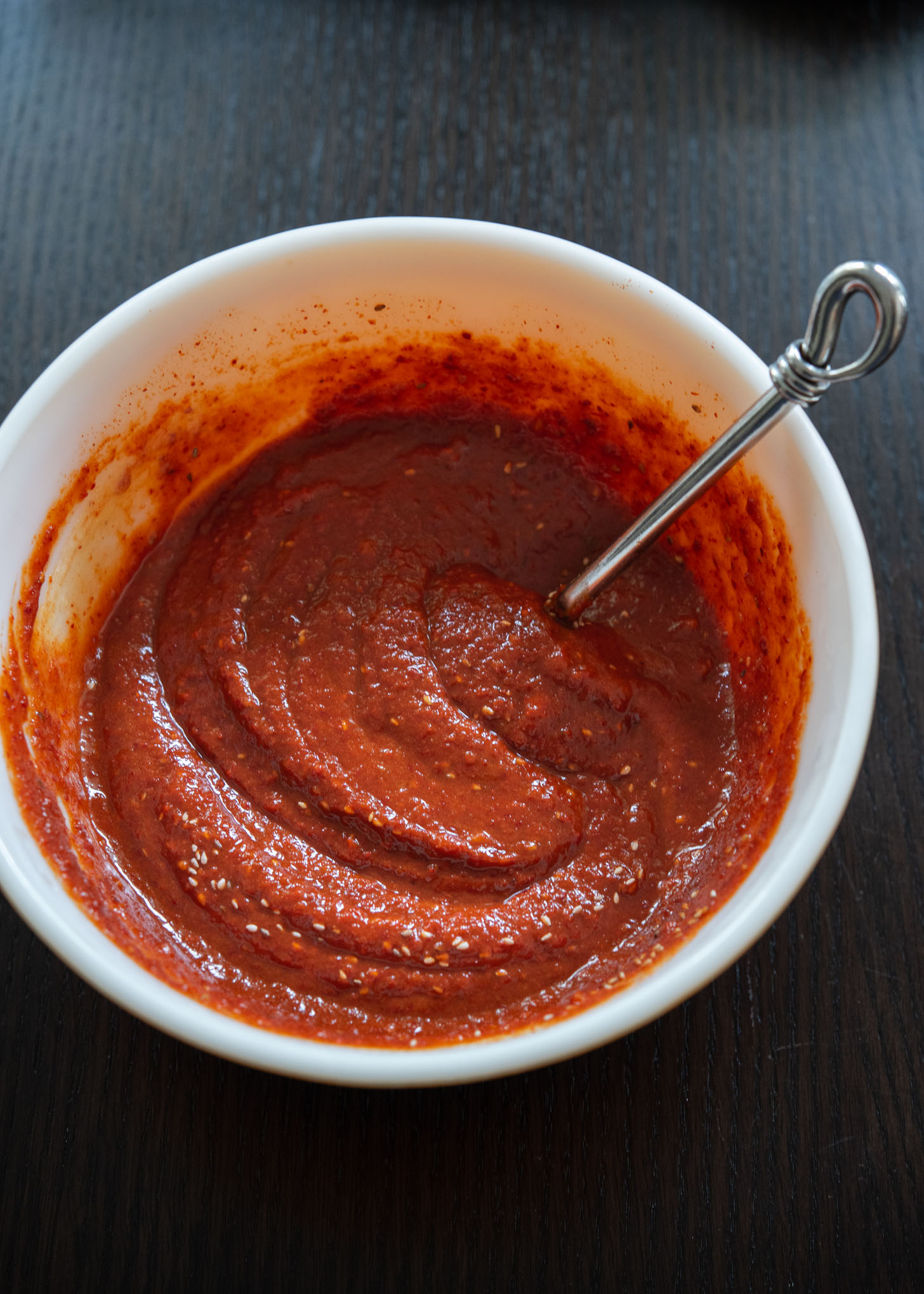
Bibim Sauce (Spicy Chili Sauce)
Instead of gochujang, I use gochugaru (Korean red chili flakes) as the base—this mirrors the North Korean-style sauce more closely and gives the noodles a cleaner, brighter heat.
The sauce starts with gochugaru, soy sauce, and vinegar, but fresh apple and pineapple really round out the heat with a hint of brightness. It’s my not-so-secret trick to getting restaurant-level flavor at home.
Make the sauce ahead of time and chill it in the fridge for at least 20 minutes (or overnight). Like kimchi, it gets better as the flavors meld.
Beef + Broth (Optional but Delicious)
Thinly sliced boiled or roasted beef is a classic topping. And a little beef broth brings it all together.
I use dashida (Korean beef stock powder) mixed with soda and mustard—then freeze it into a slush. It’s not traditional, but it’s the method a lot of restaurants use, and it helps loosen the noodles while adding just enough umami.
If you’re skipping the meat, a little warm mushroom stock (made with mushroom powder) works well too—vegan-friendly and still flavorful.
How to make Bibim Naengmyeon (Spicy Cold Buckwheat Noodles)
This dish might look complicated, but it comes together quickly once your sauce and toppings are prepped. Follow the step-by-step photos below, and check the recipe card for full instructions and measurements.
Quick Beef Broth (Optional but Worth It)
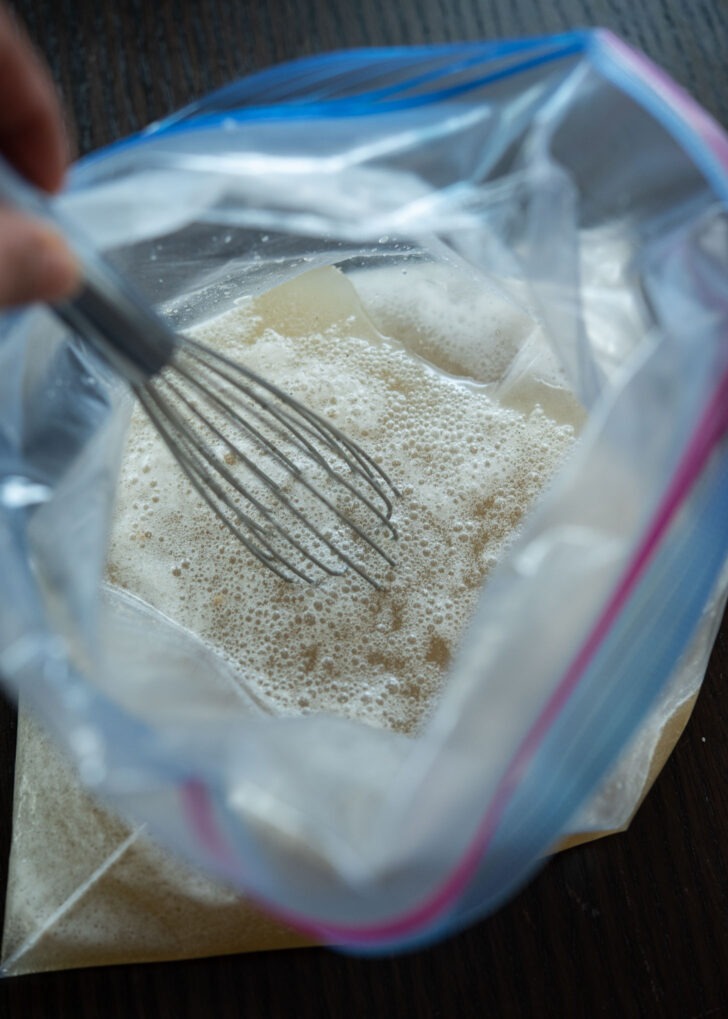
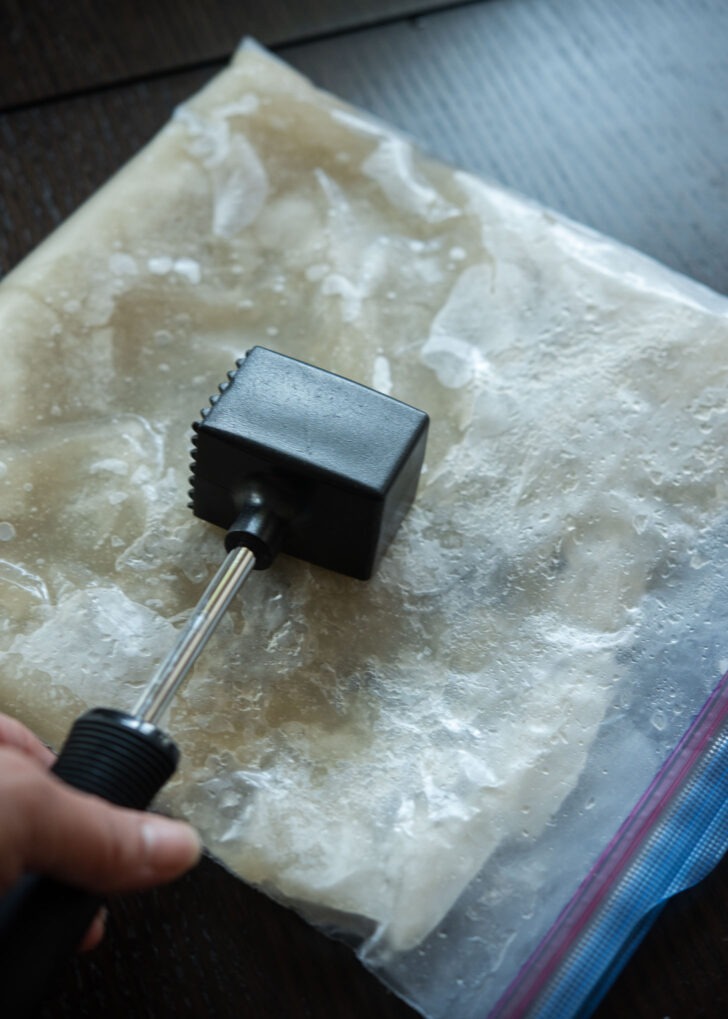
For restaurant-style flavor with less effort, mix water, a carbonated drink, Korean beef stock powder (sogogi dashida), and a dab of mustard. Freeze it flat in a zip-lock bag for 1–2 hours until slushy, then crush it just before serving. It adds a subtle depth and helps loosen the noodles.
Bibim Sauce
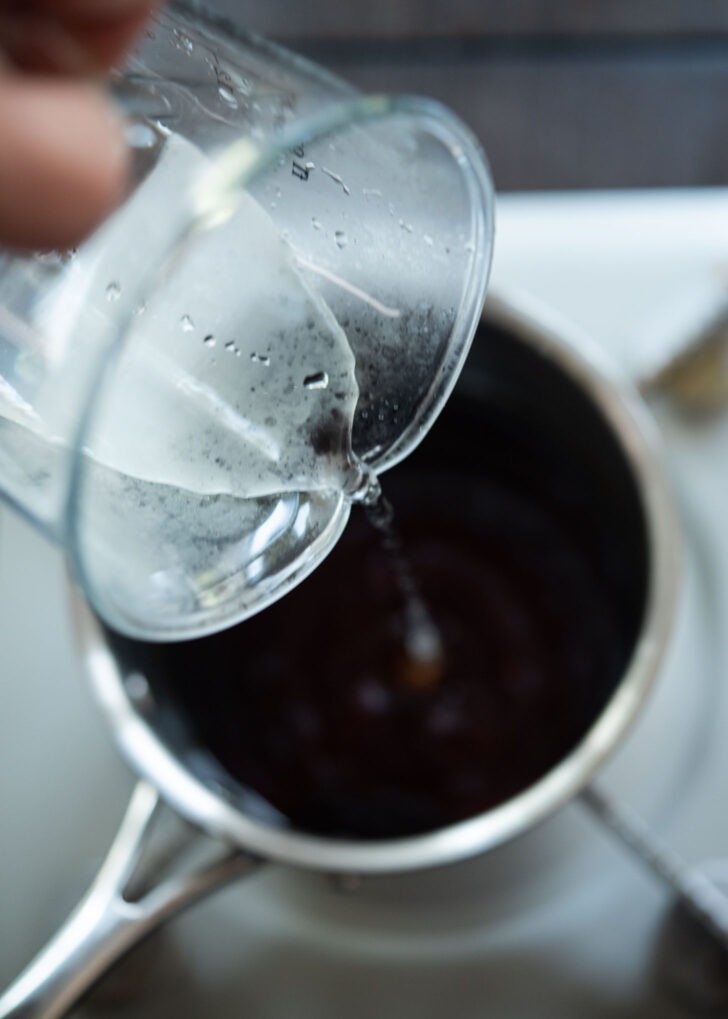
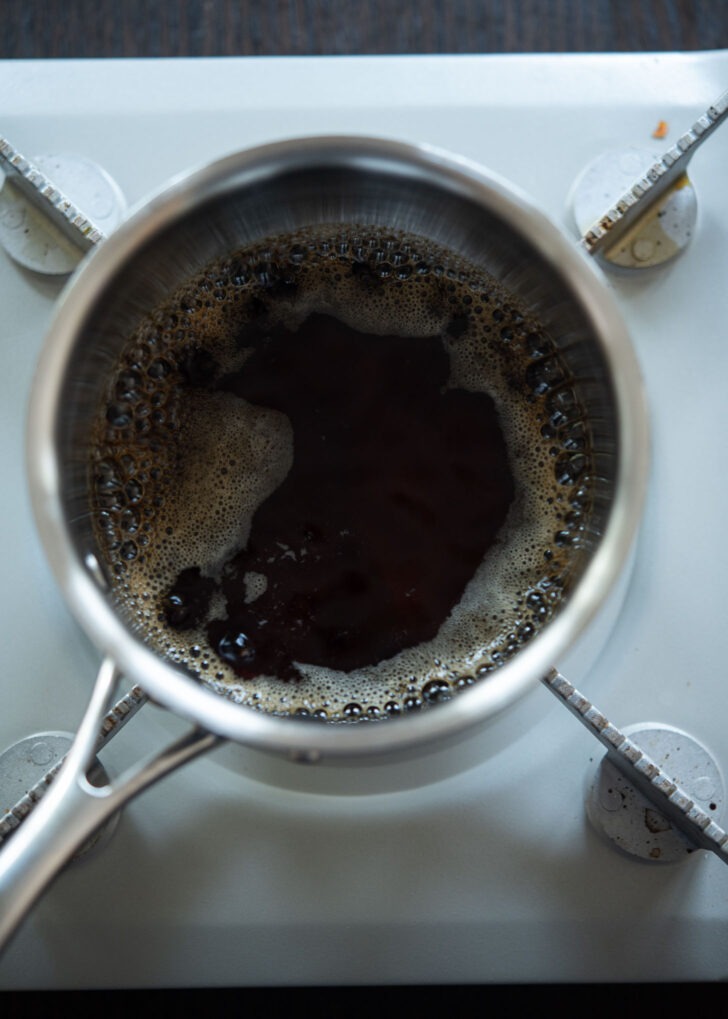
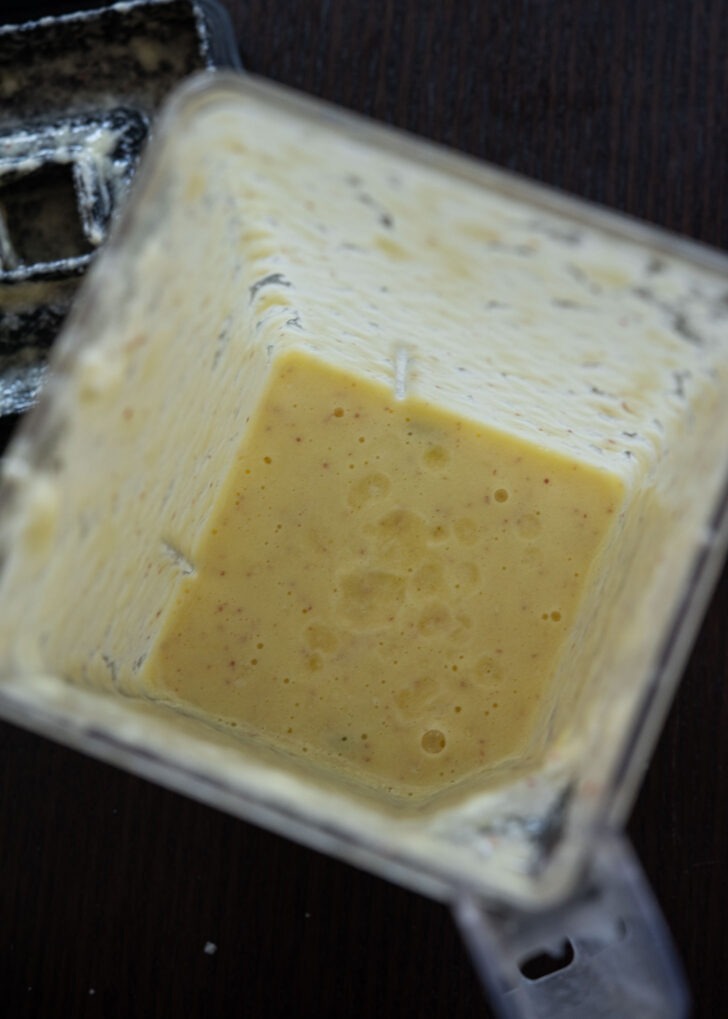
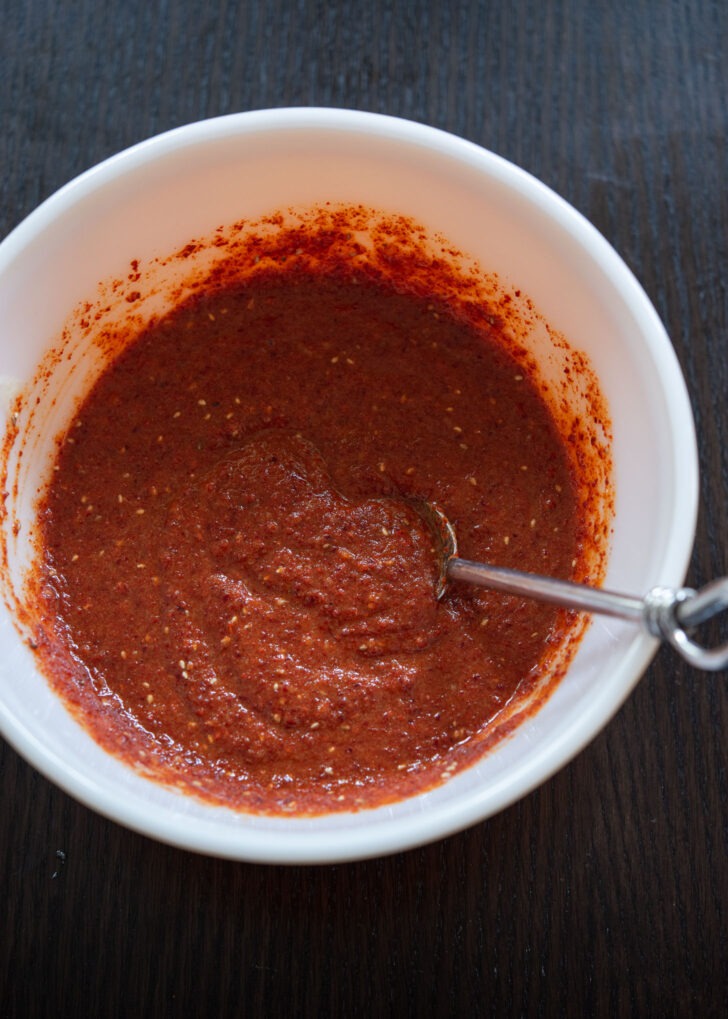
This spicy naengmyeon sauce is cleaner and brighter than the gochujang-based version you might expect. Start with a boiled soy sauce base, then blend aromatics and stir in gochugaru, sugar, sesame oil, and a touch of mustard. Let it chill until ready to use.
Radish Topping
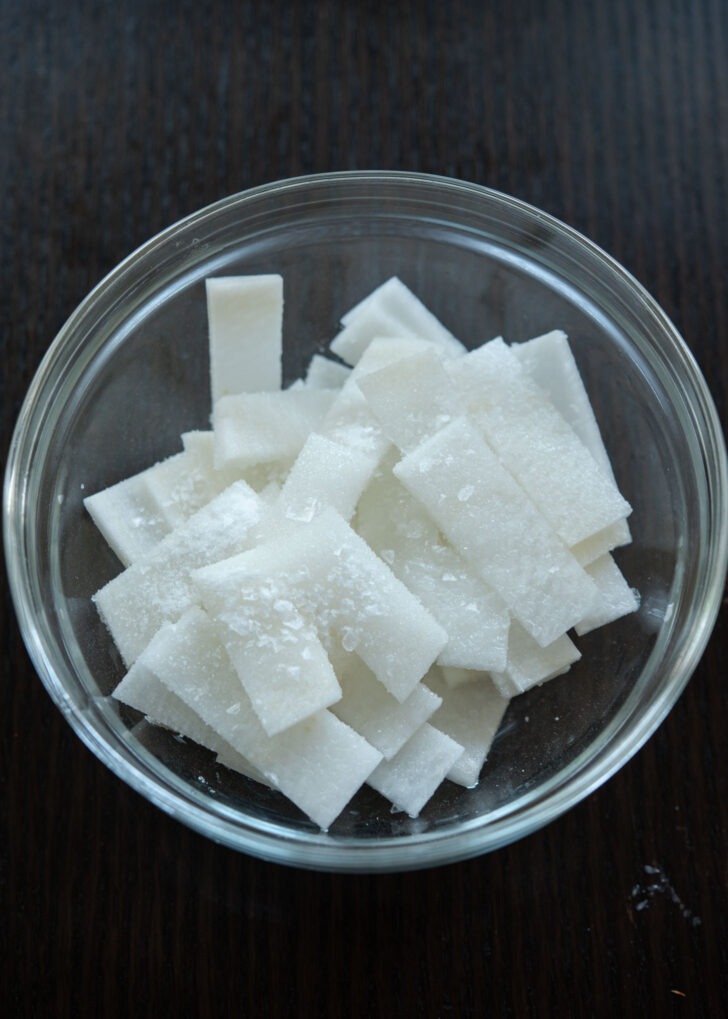
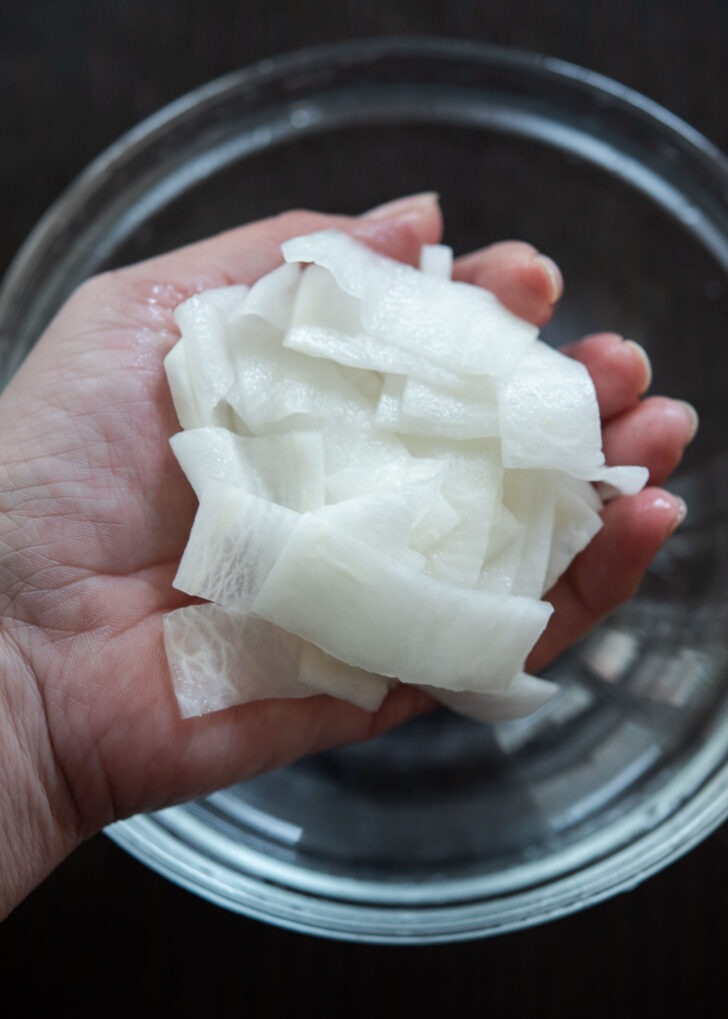
For crunch and contrast, I make a quick-pickled radish—just salt, sugar, and vinegar. It only takes 20 minutes and brightens the whole bowl.
Noodles

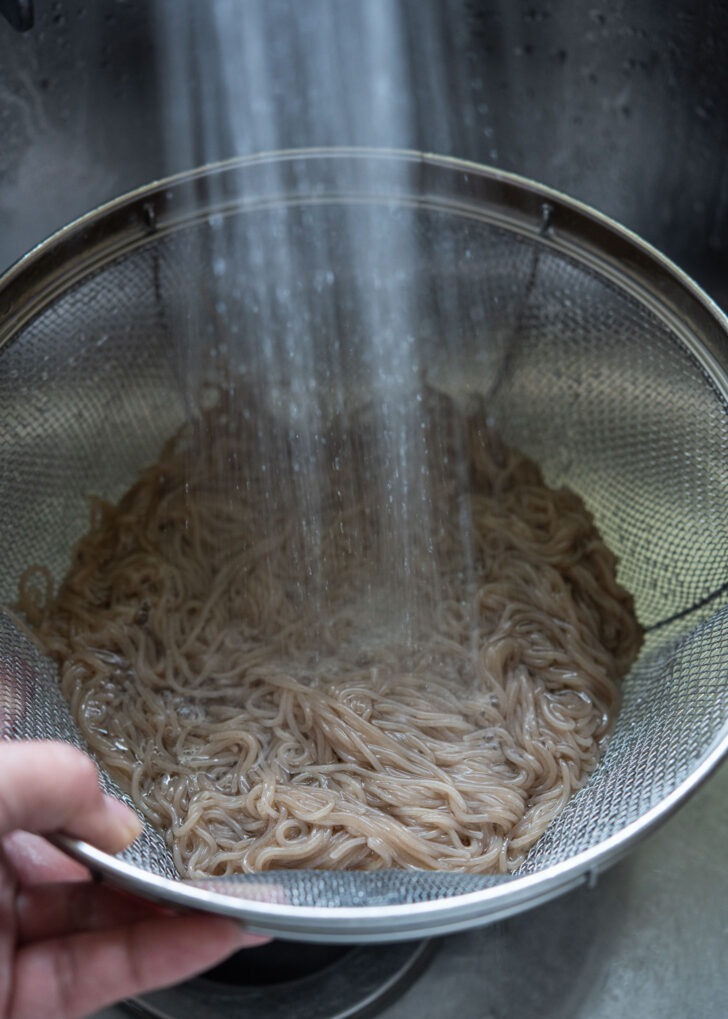
Cook the naengmyeon noodles per package directions. For extra chew, add a splash of cold water when the pot boils—repeat 2–3 times. Rinse well under cold water and drain thoroughly.
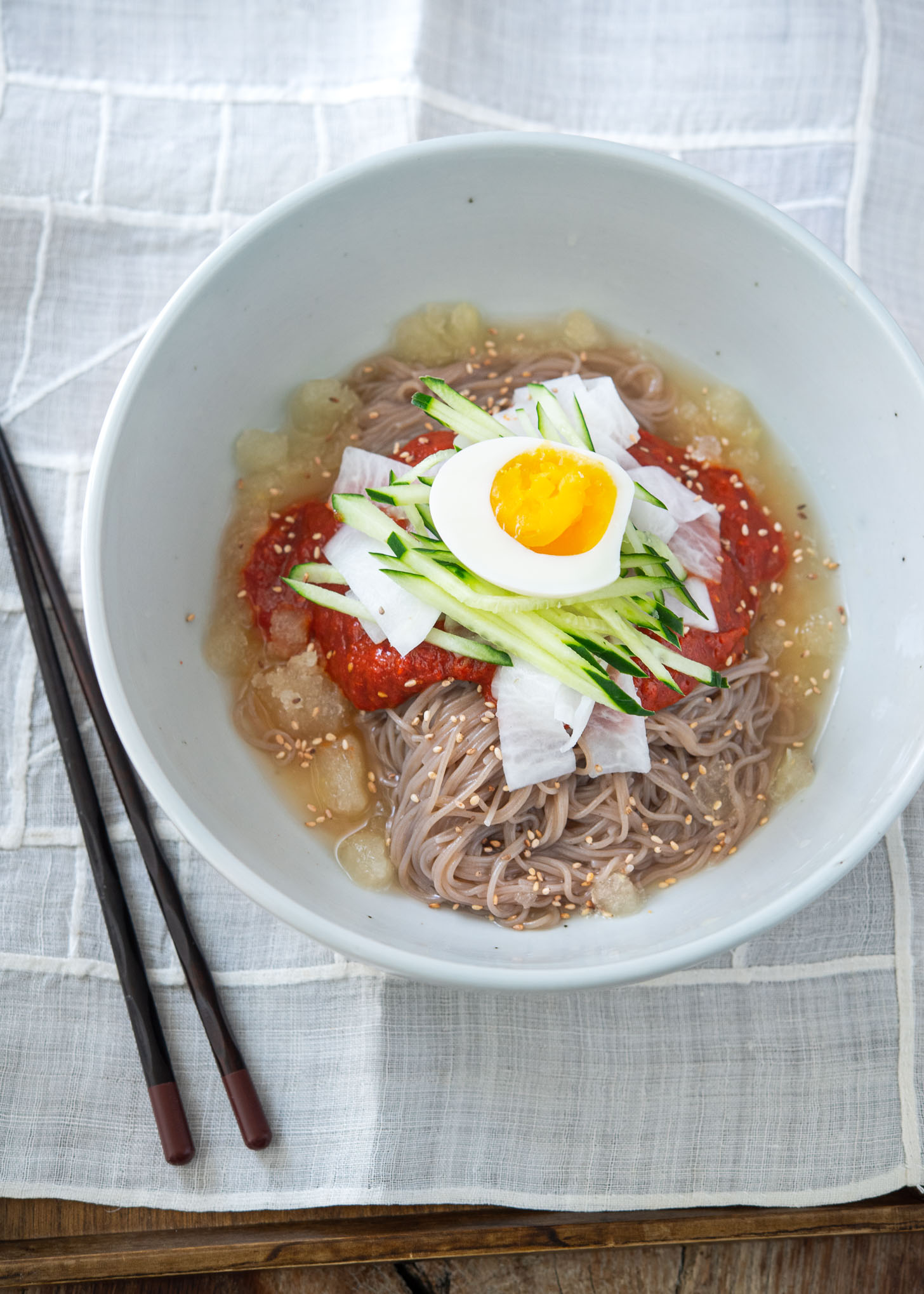
Assemble the Bowl add Serve
Spoon in a bit of icy beef broth (if using), then add the noodles. Top with sauce, pickled radish, cucumber, pear slices, and a boiled egg. Sprinkle with sesame seeds, and you’re ready to eat.
At the table, adjust the flavors to your liking with a little extra mustard or vinegar to dial up the tang and spice to your taste.
Fun fact: In Korea, naengmyeon is often one of the dishes served after Korean BBQ—alongside doenjang Jjigae—as a cool, spicy way to wrap up the meal.
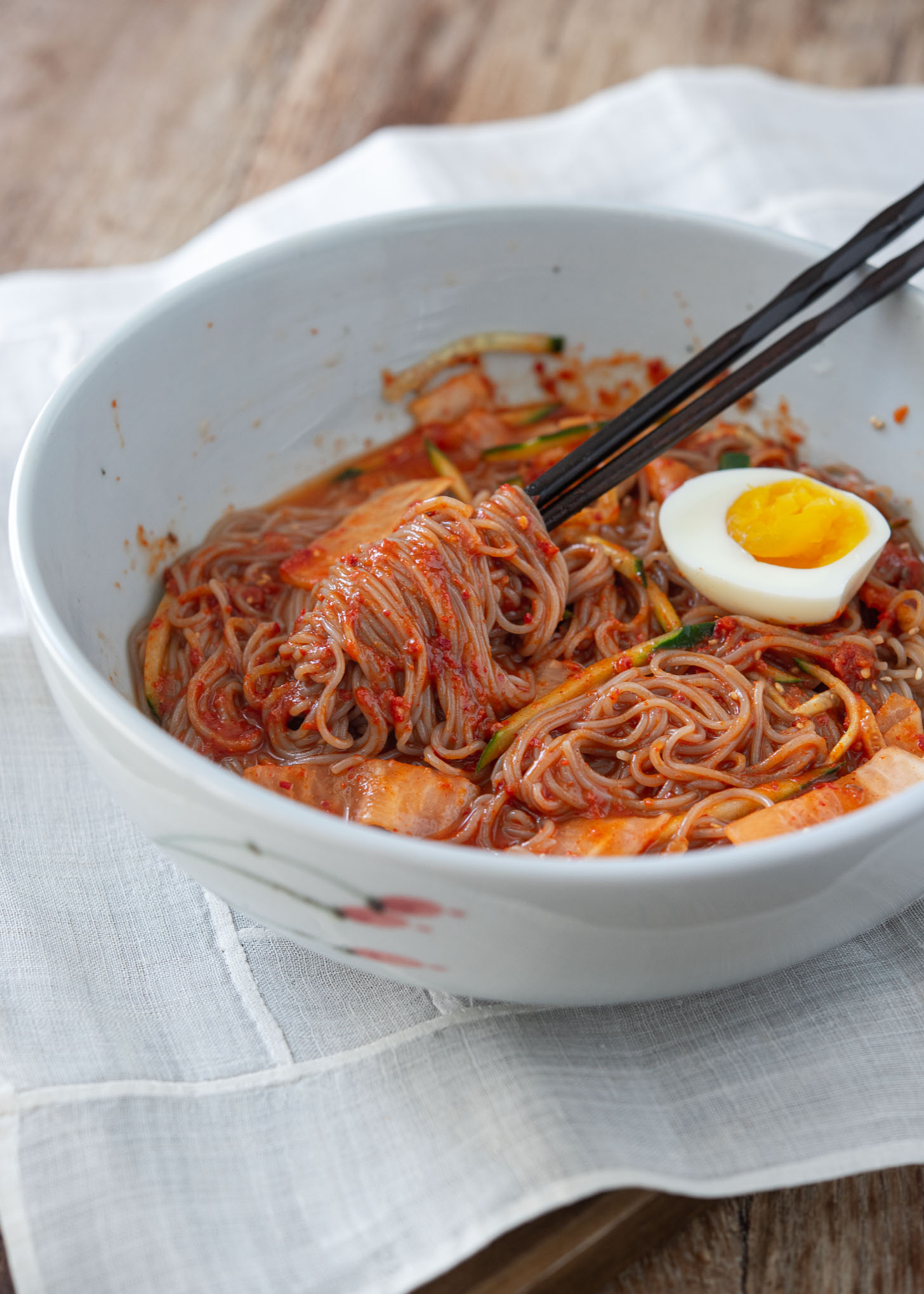
Love this recipe? Rate it and share your experience in the comments below! On Instagram? Tag me to showcase your creation. For more delicious recipes, subscribe to our newsletter!
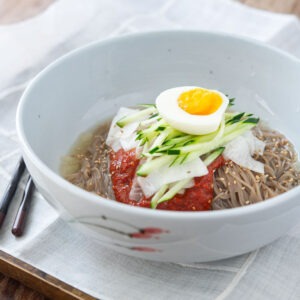
Bibim Naengmyeon (Spicy Cold Buckwheat Noodles)
Ingredients
- 8 servings Korean naengmyeon noodles
- 1 Asian cucumber, sliced to thin matchsticks
- 1/2 Korean pear or Asian pear, thinly sliced, optional
- 4 hard boiled eggs, sliced in half
Optional beef broth
- 4 cup water
- 1 cup lemon lime flavored carbonated soda
- 2 tbsp Korean beef bouillon powder (sogogi dashida)
- 4 tsp Korean mustard, or 2 tbsp dijon mustard
Quick radish topping
- 1/2 Korean radish or daikon radish, cut into 1/2-inch wide, 2-inch long thin strips
- 1 tbsp salt
- 2 tbsp sugar
- 2 tbsp vinegar
Bibim naengmyeon sauce
- 1/4 cup soy sauce
- 1/2 cup water
- 1/2 apple, peeled and diced
- 1/2 medium onion, peeled and diced
- 5 oz (150 g) fresh pineapple, or 3 rings of canned pineapple
- 1 clove garlic
- 3 tbsp water , or pineapple juice
- 1 cup Korean chili flakes (gochugaru)
- 1/4 cup white vinegar, or more
- 1/3 cup brown sugar
- 4 tbsp Korean syrup, or 3 tbsp honey
- 2 tbsp sesame oil
- 1 1/2 tsp ginger puree, or 1/2 tsp ginger powder
- 1 tsp Korean mustard , or 2 tsp dijon mustard
- 1 tsp salt
- 1 tbsp toasted sesame seeds
Instructions
To make optional beef broth
- In a zip-top bag, whisk together water, carbonated drink, beef bouillon powder, and mustard. Seal the bag tightly and lay it flat in the freezer for 1-2 hours until it becomes partially frozen.
To make naengmyeon sauce
- In a small pot, combine soy sauce and water. Bring it to a full boil over high heat, then remove from the heat and let it cool.
- In a blender, combine onion, garlic, apple, pineapple, and 3 tablespoons of water. Puree until smooth.
- Transfer the puree into a mixing bowl. Add the soy sauce mixture, Korean chili flakes, brown sugar, Korean corn syrup or honey, ginger paste, mustard, sesame oil, and sesame seeds. Mix well. Let the sauce chill in the refrigerator for at least 20 minutes or overnight.
To make radish topping
- Combine thinly sliced radish with salt, sugar, and vinegar in a mixing bowl. Let it sit for 20 minutes. Rinse the radish slices once and firmly squeeze out excess moisture. Set aside.
To cook noodles
- Bring a pot of water to a boil. Add the noodles and stir. When the water returns to a boil, add a shot of cold water. Repeat this process until the noodles are soft and chewy according to the package directions. Drain the noodles in a colander and rinse them under running cold water. Drain again.
To assemble bibim naengmyeon
- If using naengmyeon broth, crush the partially frozen broth with a meat hammer. Add 1/2 cup of the icy broth to the bottom of the serving bowl.
- Place the cooked noodles in the bowl and add about 6-8 tablespoons of the bibim naengmyeon sauce on top. Garnish the dish with pickled radish, cucumber, Korean pear (if desired), and a hard or soft-boiled egg. Sprinkle toasted sesame seeds over the dish according to your preference. Enjoy your homemade bibim naengmyeon!

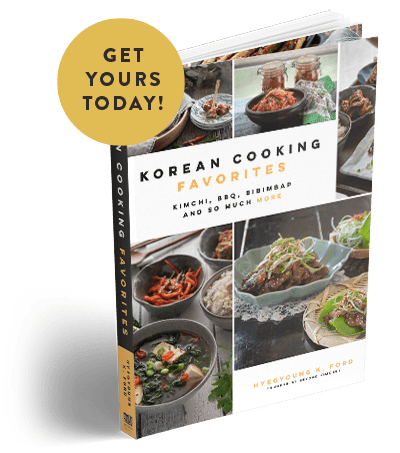
Excellent! Lots of ingredients and chopping, but the result was worth it.
Hope this is acceptable, to ask: I use Gojuchang in many recipes. Because it is in the fridge it is difficult to mix with, e.g. cucumbers. . Is there a recommended way to liquify or soften Gojuchang? Thanks.
Pour a small amount of Sprite, about 2-3 tablespoons, directly into a 1lb gochujang container and let it sit on the counter for 30 minutes. After that, stir to blend, loosening the paste. Add more Sprite if necessary. Hope this tip is helpful!
I’m excited to try this recipe, but I was just wondering what the reason is behind boiling the soy sauce and water together before adding it to the sauce?
Boiling soy sauce can help to intensify the flavor and get rid of any possible unwanted odors. However, this step is optional and can be skipped if preferred.
This was really good, I loved the heat. But now I’ve got two cups.of the sauce left over, any suggestions for what to do with it?
Use to sauce up any types of noodles – rice noodles, wheat noodles, vermicelli, etc. You can even toss with ramen noodles (without the seasoning powder), too. Top with some sliced cucumber and a hard boiled egg, and you have a simple noodle meal in no time since you have the sauce ready.
Loved the recipe! My fiancé wants the cold ice soup broth to mix with it. Would you mind sharing the recipe for that as well? I’m having trouble finding a recipe he likes it paired with.
Hi Holly,
I tried this wonderful recipe yesterday and it was delicious, like all of your recipes I cooked so far.
Now I’ve got a question about the soba noodles. When I opened the package I found a couple of sachets containing maybe 3-4 tablespoons of a liquid of light orange color. As all the descriptions are in Korean I have no idea how to use it. Could it be used as an additional sauce to your spicy goodness? Or is it a helper for the lazy cook and thought to be used as the only sauce?
And I got another question. I was finally able to find some frozen Eomuk / 어묵. Here, too, they added some spice. It is a small sachet with a reddish powder. Could it be, that I need to dissolve it in water to make some spicy sauce? Or is it to sprinkle over the Eomuk, because I found no numbers indicating an amount of liquid to use?
Vague questions, I know, but I hope you’ll have a way to help me.
Thank you!
Bee
Hi Bee
The sachet might be the sauce that comes with the noodles. But I am curious why it is light orange in color. Usually complimentary sauce in the package for this noodle is usually deep in red color. Have you checked the expiration date?
The reddish powder might be the mild chili powder that you can sprinkle directly over your 어묵soup. Taste it fist to see if it is edible to make sure, though. 🙂
Glad to hear that you got some Korean cooking going on! Happy eating!
Yes, I checked the date and it is fine. If I decifer the looking like handwritten letters correctly the name of the liquid should be 냉면 용 육수.
I will try the powder by sprinkling it on the Eomuk and you’ll here from my self-experiment in case I survive it, OK?
Thank you!
Oops, that should be *decipher of course. (Sometimes I’m just too lazy or too distracted by my kids to check the dictionary and see the obvious mistakes too late.)
Had this for supper and it was delicious! Great recipe.
Hey! Your recipe looks absolutely yummy~ I will try making it very soon!
The sauce must be made one or two days before being eaten right? Should we keep it in the fridge after making it?
Thanks!
Yes, keep the sauce in the fridge.
How do you get the noodles to be chewy? I’ve tried doing as you said with rinsing in ice water but it never comes out as chewy as when I get them at restaurant. Do I let it sit in the fridge? Also the noodles tend to clump up. How do I keep it from sticking together?
Can you use gochu jang as well for the sauce?
You can, but I highly recommend to use the chili powder instead. Paste will bring different texture to the sauce.
한국전통음식을 소개하면서 소바라고 설명하는 것은 부적절하다고 봅니다. 냉면은 이북지방 고유 음식이고 일본소바와 얼마나 관련이 있는지는 의문입니다.
영문판 위키에서 냉면을 검색해봐도 소바라는 단어는 보이지 않습니다. 삭제 또는 정정 부탁드립니다.
의견 감사합니다. 그렇군요, 소바는 일본말이라 냉면으로 표현하기는 적절하지않군요. 정정하겠습니다.
This looks wonderful! Lovely pics, as always, and a great recipe. I’ll definitely be trying this!
That sauce sounds amazing! I’m definitely going to make it once I get my hands on some pineapple! I love the chewy texture of the noodles.
wow… i bet that sauce is nuthin like the little packets you get with the prepacked Naengmyeon you get at the k.market 🙂 i gotta give it a try!
thanks
This looks fantastic! I can’t wait to try it! I love Beyond Kimchee!! Keep up the great work!!
Welcome back! Sounds like you had a great vacation. But no matter how much fun a vacation is, I, too, always enjoy returning home. Particularly if I have a dish like this to look forward to! What a great recipe. I love pasta and I love spicy, so this sounds wonderful. Great flavors, and pretty easy to make – what could be better?
I am visiting where I grew up right now.
.Funny how it used to be home and great place to visit, but Florida is home now. I love your step by step your photos.are great!..I so want to try this…I might have to ease up on the heat a bit though.
Welcome home! I love this recipe — so unusual and exotic, but still somehow comfort food. And pineapple is a surprise ingredient! I can’t wait to try this.
Thanks Ann. Pineapple adds nice flavor to the sauce without tasting any. Hope you can give this a try.
What stunning pictures. Cold noodles are all I eat nowadays. Too hot to have anything else! Thanks for the bibim naengmyun recipe. I always eat the packaged ones, but now I know.
Mabel
Thanks Mabel. I guarantee this spicy Naengmyeon will beat your summer heat. Tastes far much better than the package kind.
I love this! I was never a big fan of nengmyon when I lived in Korea but now I love it! Funny how my appetite changes overtime! This looks fabulous.
Believe me, my appetite changes every day. Naengmyeon is great dish to turn up the lost appetite.
I totally agree with the sentiment that home’s the best. Thanks for posting all the step by step photos, korean food is one of my favourite, this recipe looks so delicious, time to visit my favourite korean restaurant soon. Thanks for sharing 🙂
Yes, Korean food is my favorite too. Thanks for stopping by!
I tried this once and simply loved the texture of the noodle and the ultra spicy sauce 🙂 Certainly a great dish for a place like Malaysia where its summer all year round. Thanks for the recipe Holly! I hope you had great vacation.
Hi swan, good to hear from you. Of course I believe any Malaysian can handle the spicy Korean sauce. Just perfect match!